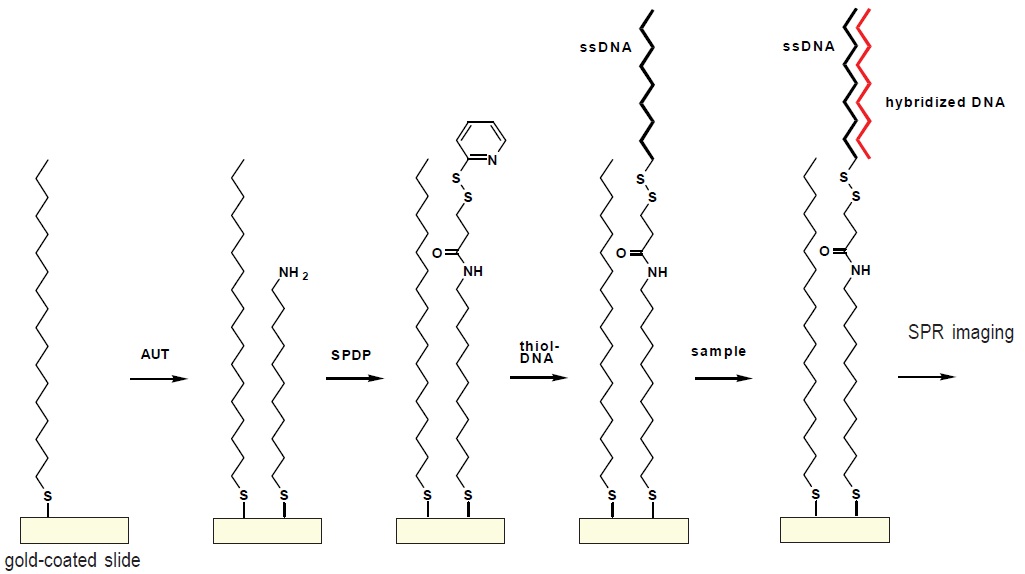Amino-EG6-undecanethiol, hydrochloride

Self Assembled Monolayer Reagent
-
Product codeA483 Amino-EG6-undecanethiol, hydrochloride
-
CAS No.496839-01-1(free base)
-
Chemical name20-(11-Mercaptoundecanyloxy)-3,6,9,12,15,18-hexaoxaeicosane-1-amine, hydrOchloride
-
MWC23SH50ClNO6S=504.16
| Unit size | Price | Item Code |
|---|---|---|
| 10 mg | Find your distributors | A483-10 |
Description
Structural Formula

Product Description
Polyethyleneglycols (PEGs) are widely used for material modifications to improve hydrophilicity of the surface. PEG-coated materials are usually more stable under physiological conditions. Since Amino-EG6-undecanethiol has 6 ethylene glycol units, 11 carbon atoms, and an SH group at the end, it can be used to prepare a highly oriented and hydrophilic SAM on a gold surface. This is suitable for biomaterial labeling on the surface due to the improved hydrophilicity. The hydrophilic surface can prevent proteins or other biomaterials from non-specific binding. Therefore, the SAM prepared by this reagent will provide a better surface to develop biomaterial sensors or DNA/ protein microarrays. To prepare an Amino-EG6-SAM on a gold surface, hydroxy-EGn-undecanethiols (n=3, 6) are used to dilute the number of amino groups according to the density of the molecules being introduced onto the surface.
Technical info
How to Prepare SAM
1. Soak a gold-coated glass plate in Piranha solutiona) for 10-15 minutes. Wash the plate with purified water.a)
2. Dissolve aminoalkanethiol compound in ethanol to prepare several mM to several ten mM solutions.
3. Soak the plate in the aminoalkanethiol solution for a certain time period.b)
4. Wash the SAM-coated plate with ethanol and then water.
5. Dry the plate under nitrogen atmosphere, if necessary.
a)Piranha solution: sulfuric acid and 30% hydrogen peroxide, 3:1. Piranha solution is a strong oxidizing agent. Extreme care is necessary when using it.
Do not apply Piranha solution to resin-coated plates; it may erode the resin.
b)To prepare a SAM-coated plate with the best performance, aminoalkanethiol concentration and soaking time should be individually determined.
Application of SAM-Preparation of DNA Array (Fig. 1)
1. Use SF10 glass slides (Schott Glass Technologies) coated with 5 nm chromium and 45 nm gold thin film.
2. Soak the glass slide in a 1 mM 1-octadecanethiol (ODT)/ethanol solution overnight to prepare ODT SAM-coated slide.
3. Draw 500 μm x 500 μm patterns on the ODT SAM-coated slide by UV irradiation with an Hg-Xe arc lamp.a)
4. Soak the slide in a 1 mM 11-amino-1-undecanethiol (AUT)/ethanol solution for 2 hours to form AUT SAM on the 500 μm x 500 μm photopatterned area.
5. Drop 2 mM SPDP solutionb) onto the slide and leave the slide at room temperature.
6. Wash the slide and dry under nitrogen atmosphere.
7. Apply 1 mM thiol-DNA solutionc) to each 500 μm x 500 μm pattern and incubate at room temperature overnight.
8. Incubate the slide with a sample solution for 10 minutes and wash with phosphate buffer, followed by SPR imaging.
a)Irradiation time: 1-1.5 hours
b)SPDP: N-succinimidyl 3-(2-pyridyldithio)propionate. Dissolve SPDP in DMSO to prepare 50 mM solution. Dilute it 25 times with 100 mM triethanolamine buffer, pH 7.0.
c)Dissolve thiol-DNA with 100 mM triethanolamine buffer, pH 8.0.
Fig. 1 DNA Array Preparation Scheme

References
1) C. Pale-Grosdemange, E. S. Simon, K. L. Prime and G. M. Whitesides, Anal. Chem., 1999, 71, 777.
2) M. Kyo, K. Usui-Aoki, H. Koga, Anal. Chem, 2005, 77, 7115.
3) G. B. Sigal, M. Mrksich and G. M. Whitesides, J. Am. Chem. Soc., 1998, 120, 3464.
4) Y. Li, H. J. Lee and R. M. Corn, Nucleic Acids Research, 2006, 34, 6416.
Handling and storage condition
| Appearance: | White to pale yellow solid |
|---|---|
| Purity (HPLC): | ≧ 90.0 % |
| NMR spectrum: | Authentic |
| -20°C, Nitrogen substitution, Protect from moisture |












